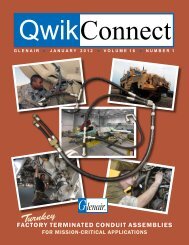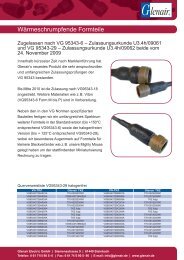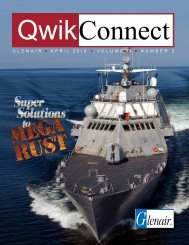RoHS - Glenair UK Ltd
RoHS - Glenair UK Ltd
RoHS - Glenair UK Ltd
Create successful ePaper yourself
Turn your PDF publications into a flip-book with our unique Google optimized e-Paper software.
New Non-Toxic Plating Choices<br />
Available Now @ <strong>Glenair</strong><br />
At present, <strong>Glenair</strong>’s customers specify<br />
cadmium plating on parts more often than<br />
any other finish treatment. Although cadmium<br />
plating is exempted under the Restrictions of<br />
Hazardous Substances (<strong>RoHS</strong>), there continues<br />
to be considerable impetus in the military and<br />
industrial sectors to reduce use of cadmium<br />
and other common plating substances, such as<br />
hexavalent chromium.<br />
The Joint Group on Pollution Prevention<br />
(JG-PP), a partnership between the Military<br />
Services, NASA, DLA, and DCMA, appointed<br />
a Joint Cadmium Alternatives Team (JCAT)<br />
and sponsored a Hexavalent Chromium<br />
Coating Alternatives Technology Survey to<br />
find replacements for these two substances.<br />
Thus far, efforts to identify cadmium substitutes<br />
have proven more successful than hexavalent<br />
chromium replacements. Not surprisingly, any<br />
material active enough to provide corrosion<br />
control has high potential to also be a health and<br />
environmental hazard.<br />
Cadmium plating offers interconnect<br />
designers excellent corrosion resistance,<br />
lubricity, solderability, adhesion and ductility.<br />
The main drawback of cadmium is its purported<br />
toxicity. The search for cadmium alternatives<br />
has been challenging, as replacements need<br />
to provide simultaneously 1) lubrication and<br />
consistent friction control, 2) protection to<br />
substrate aluminum or alloy steel from corrosion,<br />
3) a barrier coating base, and 4) galvanic<br />
protection for compatibility between dissimilar<br />
metals such as aluminum and steel.<br />
Cadmium replacement options often<br />
require a post-treatment chromate conversion<br />
coating for enhanced appearance and<br />
additional corrosion protection. The best choice<br />
for conversions is hexavalent chromium.<br />
Conversion coatings without hexavalent<br />
chromium are available, and they can yield<br />
QwikConnect n·<br />
January 2009<br />
fair salt spray results, but they generally lack<br />
hexavalent chromium’s self-healing property.<br />
Newer trivalent chromium conversions<br />
in combination with rare earth metals such<br />
as vanadium show promise to match the<br />
performance of traditional hexavalent chromium<br />
processes, but not without significant drawbacks.<br />
Trivalent chromate requires additional controls,<br />
increasing its expense. Originally thought to be<br />
non-toxic, chromium in the trivalent variety can<br />
oxidize to the toxic hexavalent form at a rate of<br />
7% to 10% when exposed to air, and at even<br />
greater rates in ground water.<br />
<strong>Glenair</strong> has offered cadmium-free zinc nickel<br />
for some time, and now offers AlumiPlate and a<br />
nickel-PTFE plating superior to standard nickelfluorocarbon<br />
polymer finish treatments. Both<br />
AlumiPlate and Ni-PTFE (see next page) are<br />
free of cadmium and hexavalent chromium.<br />
AlumiPlate SM<br />
AlumiPlate aluminum coating provides<br />
excellent conductivity and corrosion<br />
protection particularly in salt and other acidic<br />
environments. The AlumiPlate layer is pore free<br />
and provides a robust physical barrier. The pure<br />
aluminum coating forms a thin, tenacious, nondegenerating<br />
oxide almost immediately upon<br />
contact with air. This aluminum layer acts to<br />
“heal” scratches or impingements on an ongoing<br />
basis.<br />
Typically a 0.5 mil AlumiPlate aluminum<br />
coating (with no chromate conversion) will<br />
provide over 1,200 hours of ASTM B117<br />
salt spray resistance. It also protects from<br />
galvanic corrosion in steel-to-aluminum (and<br />
various other dissimilar metals-to-aluminum)<br />
applications.<br />
Unlike many conventional platings which<br />
are destroyed or lost at higher temperatures,<br />
AlumiPlate aluminum offers good protection<br />
for base metals in extremely high temperature<br />
applications, as the melting point of aluminum is<br />
1,220ºF (660º C).<br />
17











